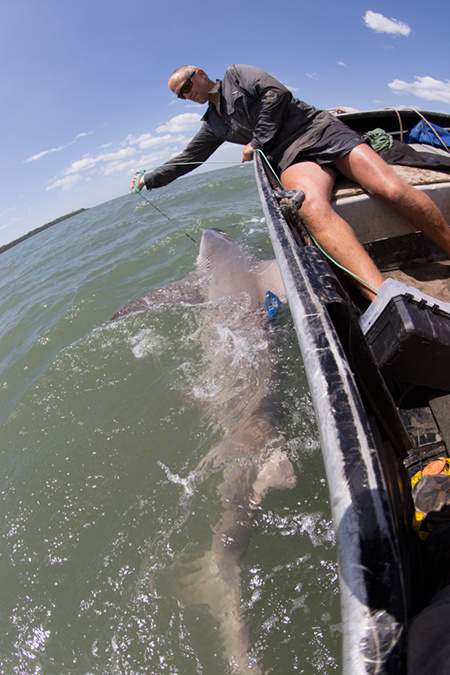Rare speartooth sharks caught in Australia
 0 Comment(s)
0 Comment(s) Print
Print E-mail China.org.cn, November 11, 2015
E-mail China.org.cn, November 11, 2015
 |
|
A male speartooth shark is satellite tagged in remote Cape York. [Photo/CSIRO] |
The first ever adult speartooth sharks have been caught and satellite tagged by scientists from the Commonwealth Scientific and Industrial Research Organisation working in remote Cape York.
The elusive shark species - listed as critically endangered - was discovered in the Bizant River on the eastern side of Cape York in Queensland in 1982, but up until now only juvenile specimens had been observed.
The two adult specimens captured were well over two metres in length. Before that, the largest recorded Speartooth Shark was only 189cm long.
Very little was known about the Speartooth Shark until research led by CSIRO in 2004 began to obtain a better understanding of the distribution of juveniles in a few river systems in tropical Australia.
"We've been conducting research into the movement and population status of juvenile Speartooth Sharks in the Wenlock River since 2006, and due to our long-term research we now know that juveniles are restricted to a few river systems in the Northern Territory and Queensland," CSIRO researcher Dr Richard Pillans said.
"But the lack of records of adults is a key gap in our understanding of this species, which is listed as Critically Endangered by the Environment Protection and Biodiversity Conservation (EPBC) Act."
According to Dr Pillans (pictured with a tagged shark, right) the chances of catching the adult specimens were incredibly small.
"We know from catching newborn Speartooth Shark with open umbilical scars in late October – December that the females are giving birth during this period, with preliminary estimates of total female adult population to be less than 500 sharks," he said.
Despite these low odds, over nine days of intensive sampling Dr Pillans, Barry Lyon and Luke Burnett (Australia Zoo) managed to capture two adult Speartooth Sharks - the first records of adults of this species in Australia and the first live specimens recorded by researchers anywhere.






Go to Forum >>0 Comment(s)